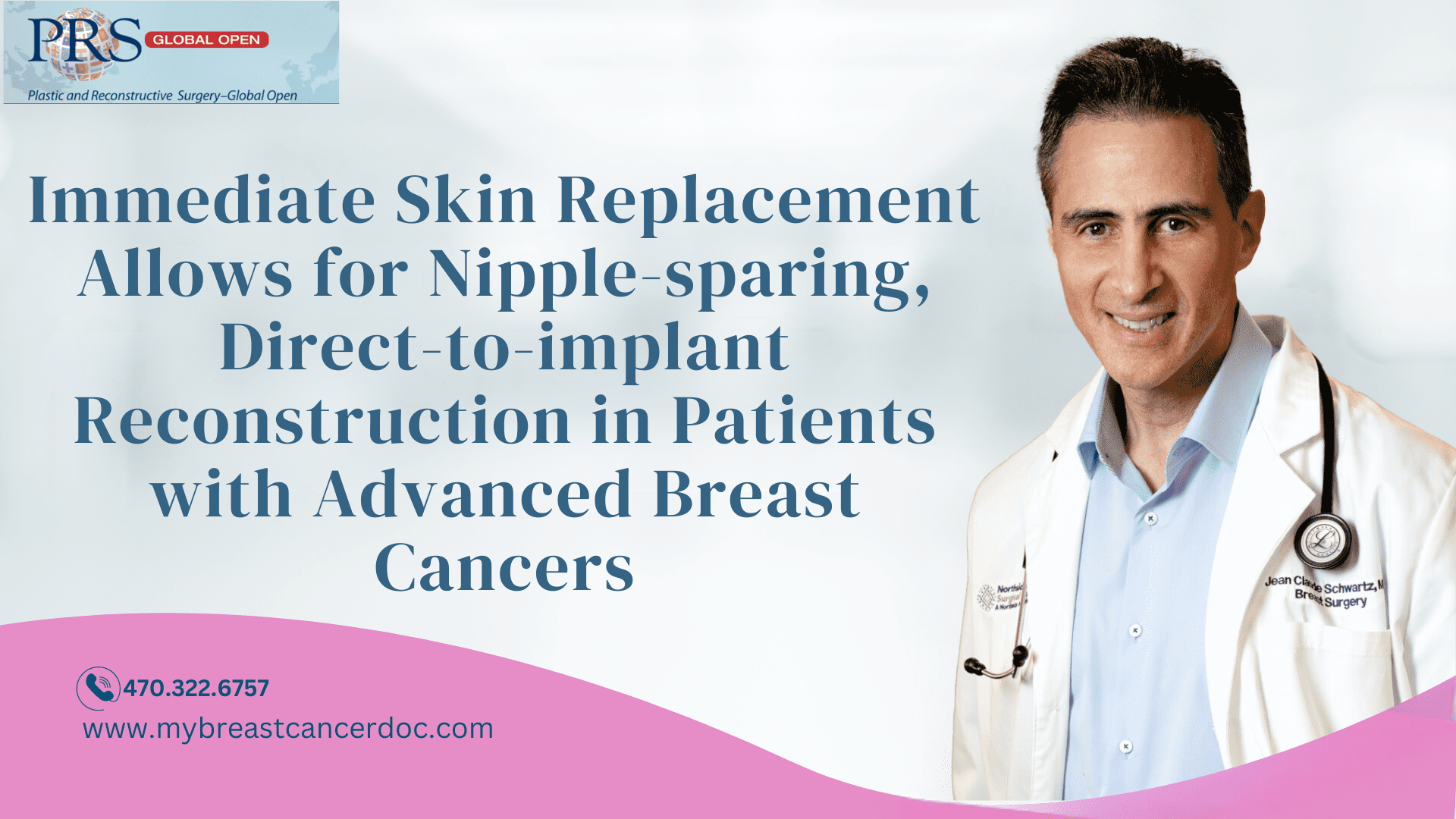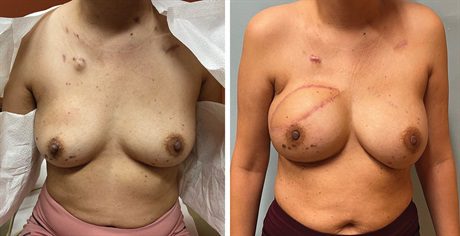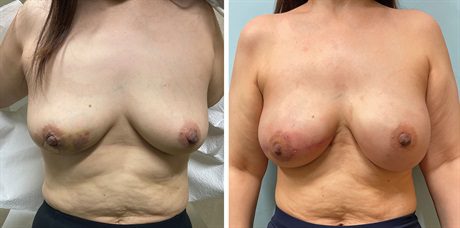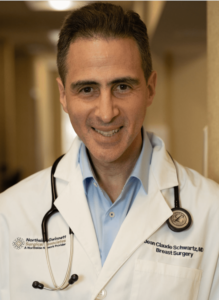Fax: 770-339-9804
Lawrenceville, Georgia 30046


Originally published on PRS Global Open website in February 2022.
Mastectomy has evolved from approaches that involved extensive skin resection to nipple-sparing mastectomy (NSM). However, patients with advanced breast cancers who require extensive skin resection usually also have their nipple areola complexes (NACs) removed, even if they are distant from the cancer. Implant reconstruction in these patients is challenging as they require tissue expansion and, typically, radiotherapy with additional surgeries to complete their reconstruction. The aesthetic results of this approach are inferior to NSM and direct-to-implant reconstruction. In patients who require significant skin resection but whose NACs are free of tumor, we have found that immediate skin replacement using a muscle-sparing latissimus dorsi flap allows for NSM and direct-to-implant reconstruction, obviating the need for tissue expansion, delayed implant placement, and NAC reconstruction. Here, we report on 12 patients in whom this approach is utilized.
Question: How can we perform NSM and DTIR in advanced breast cancers that require extensive skin resection?
Findings: The muscle-sparing latissimus flap provides a minimally invasive approach to facilitate immediate skin replacement for advanced cancers, allowing for NSM and DTIR.
Meaning: Patients with advanced cancers that require extensive skin resection are still potential candidates for NSM and DTIR after mastectomy by immediately replacing the resected skin with a flap.
Regular mammographic screening allows for most cancer diagnoses to occur at an early stage.1 In women who undergo mastectomy, the entire skin envelope, including the nipple areola complex (NAC), can often be preserved. The preservation of skin facilitates direct-to-implant reconstruction (DTIR).2 DTIR coupled with prepectoral implant placement has allowed many women to undergo a single outpatient surgery with definitive reconstruction without the need for additional surgery.3
This approach is often not possible in women with more advanced cancers that require extensive skin resection. In these surgeries, the nipple is typically resected as well, despite the fact that NAC preservation in patients with locally advanced disease can be performed safely.4,5 In these patients who desire implant reconstruction, tissue expansion is necessary to create a large enough skin envelope to accommodate a definitive implant in a subsequent surgery. NAC sacrifice is sensible here as tissue expansion would likely result in significant malposition. Here, we describe an approach in women with advanced cancers where diseased skin is immediately replaced with a muscle-sparing latissimus dorsi (MSLD) flap, allowing for nipple-sparing mastectomy (NSM) and DTIR.
This study was approved by the Gwinnett Surgical Ambulatory Surgery Center/Northside Hospital Institutional Review Board (Lawrenceville, Ga.) and approved as a nonsignificant risk study. Women requiring skin resection during mastectomy who desired implant reconstruction and nipple preservation were offered skin replacement using the MSLD flap with prepectoral DTIR (Figs. 1 and 2; see figure, Supplemental Digital Content 1, which shows the 1.45-degree lateral view of the right breast reconstruction, https://links.lww.com/PRSGO/B919; and see Video [online], which demonstrates our approach for using the muscle-sparing latissimus dorsi flap to facilitate skin replacement, NSM, and implant-based reconstruction. Although the patient in this video had her skin replacement performed several weeks after her initial surgery [which demonstrated multiple involved skin margins over a broad area], most of our patients in this series were offered DTIR with immediate skin replacement when we anticipated that the anterior margin would be difficult to clear or the resection might result in significant devascularization of the mastectomy flap). Nipple preservation was deemed safe based on clinical examination, preoperative imaging, and intraoperative frozen section. Intraoperative gross evaluation of mastectomy margins were also obtained to help facilitate obtaining clear microscopic margins. The area of skin requiring resection was determined preoperatively, which aided in designing the MSLD skin island. Patients were then returned to the supine position for bilateral NSM and prepectoral DTIR with acellular dermal matrix (cortiva reference DH 16 × 20; RTI Surgical, Alachua, Fla.) using an ex vivo wrap method.6 On the side requiring skin resection, the MSLD skin paddle replaced skin in a 1:1 fashion and the remainder was deepithelialized and placed into the mastectomy pocket to assist with coverage. Typically, a smaller implant was used with the MSLD to account for the flap volume and obtain symmetry. Contralateral mastectomy and reconstructions were performed through inframammary incisions. This surgery was also performed when final pathology revealed extensively involved anterior margins after an attempt at standard NSM and reconstruction. (See Video [online], which demonstrates our approach for using the muscle-sparing latissimus dorsi flap to facilitate an NSM and implant-based reconstruction.) All surgeries were performed at our outpatient surgery center. (See figure, Supplemental Digital Content 1, https://links.lww.com/PRSGO/B919.)
This video demonstrates our approach for using the muscle-sparing latissimus dorsi flap to facilitate skin replacement, NSM and implant-based reconstruction. Although the patient in this video had her skin replacement performed several weeks after her initial surgery (which demonstrated multiple involved skin margins over a broad area), most of our patients in this series were offered DTIR with immediate skin replacement when we anticipated that the anterior margin would be difficult to clear or the resection might result in significant devascularization of the mastectomy flap.
 Fig. 1.:
Fig. 1.:
Preoperative and postoperative photographs of a 42-year-old woman with triple negative breast cancer enlarging on neoadjuvant chemotherapy, which unfortunately predicts a poor long-term prognosis. Her medical oncologist requested a mastectomy before proceeding with additional systemic therapy. We proceeded with bilateral mastectomy and immediate prepectoral DTIR in 192 minutes with same-day discharge. On the right, we replaced the resected skin with an MSLD skin paddle, preserving the nipple and providing acceptable symmetry with the contralateral side. Her margins are widely clear and her surgery is definitive, which allows her to move on with additional oncological treatments without planned additional surgeries to complete her reconstruction.
 Fig. 2.:
Fig. 2.:
Preoperative and postoperative photographs (6 months, no radiotherapy given) of a 44-year-old woman with 10 cm of DCIS in the inferior pole of the right breast. The DCIS was palpable underneath the skin in several areas and breast MRI revealed no significant plane between the cancer and skin. We proceeded with bilateral mastectomy and immediate prepectoral DTIR in 216 minutes with same-day discharge. We resected all of her right breast inferior pole skin and immediately replaced this with an MSLD skin paddle. Her nipple was distant from the disease and could be preserved. We replaced the entire inferior right breast subunit with skin, which contributes to the excellent aesthetic result obtained. Her margins are widely clear (>5 cm) and she does not require adjuvant chemotherapy, radiotherapy or antihormonal therapy. A 45-degree lateral view of the right breast reconstruction is shown in Supplemental Digital Content 1 (https://links.lww.com/PRSGO/B919).
Twelve women underwent bilateral NSM for unilateral breast cancers (see table, Supplemental Digital Content 2, which shows patient demographics, operative details, complications, and outcomes, https://links.lww.com/PRSGO/B920). The mean age was 54.2 years (range, 31–73 years) and mean body mass index was 27.7 kg/m2 (range, 22.2–36.2 kg/m2). The indications for surgery included extensive ducal carcinoma in situ involving the skin (3/12, 25%), invasive cancer progression on chemotherapy (2/12, 16.7%), tumors with poor response to chemotherapy (4/12, 33.3%), and locally advanced cancers that were taken to surgery as initial treatment as they were not chemosensitive (3/12, 25%). The mean operative time was 236.7 minutes (range, 184–292 minutes). Nine patients with invasive cancer underwent radiotherapy. One patient required surgery for flap debridement and implant exchange with salvage of her reconstruction. The average follow-up time after radiotherapy (or definitive surgery in patients with ductal carcinoma in situ (DCIS) not requiring radiation) was 7.5 months (range, 3–19 months), with a minimum of 3 months. There have been no instances of reconstructive failure after radiotherapy. Two patients underwent revision with fat transfer six months after radiotherapy. Three patients underwent MSLD skin replacement after their initial surgical pathology revealed involved skin margins over a broad area.
NSM with prepectoral DTIR using cohesive implants and acellular dermal matrix can provide patients with excellent aesthetic results in a single outpatient surgery.2 This relies on preservation of the skin envelope and nipple, if oncologically safe. Unfortunately, surgeons still encounter patients with extensive disease that requires sacrifice of significant skin and the nipple, even if the NAC is distant from the cancer and can be salvaged. Many of these patients have an excellent prognosis and are good candidates for immediate reconstruction. In the past, these patients would undergo resection of a large area of skin and NAC with immediate or delayed expander placement followed by multiple office visits for tissue expansion, followed by additional surgeries, or they would require autologous reconstruction. These patients lose the aesthetic benefits of NSM and often require a multistage reconstruction. This process is often complicated by ongoing chemotherapy and or radiotherapy resulting in inferior aesthetic outcomes and risk of reconstructive failure.7
Here, we present an alternative approach where we salvage the portion of the mastectomy flap that is free of tumor, including the NAC, preserve the breast footprint and use a quickly dissected, minimally invasive flap to replace the skin, restore breast contour and proceed with NSM and DTIR. The MSLD has been well described in immediate and delayed breast reconstruction, most commonly with an expander or permanent implant.8 Previous reports have detailed use of these flaps to immediately replace just the NAC or large areas of skin after a nonskin sparing mastectomy to facilitate either single-stage or two-stage reconstructions.9 To the best of our knowledge, this is the first report to demonstrate the utility of a flap to facilitate an NSM and DTIR in more advanced cancers requiring significant skin resection.
In the modern era, many of these “advanced” cancers are determined to be more indolent after genomic analysis despite significant in-breast disease burden and positive lymph nodes.10 These patients are therefore good candidates for immediate reconstruction. Even in patients who require chemotherapy and radiotherapy, our approach provides for an NSM and DTIR obviating the need for tissue expansion during or after chemotherapy and or radiotherapy, which has been shown to increase reconstructive failure rates.7 We chose the MSLD over the thoracodorsal artery perforator flap as this flap is simpler, quicker, and safer to dissect in our hands without requirement for microvascular dissection. Our approach described here extends the benefits of NSM to patients not previously offered this option in addition to allowing them to complete their reconstructions in one surgery instead of multiple surgeries over an extended period of time.
Extensive breast cancers often require significant skin resection. This usually excludes these patients from NSM even if the NAC is distant from the cancer and requires, in patients who desire implant-based reconstruction, immediate or delayed tissue expansion before or after radiotherapy. This approach leads to poor aesthetic results requiring multiple surgeries over an extended period of time with high rates of reconstructive failure. We demonstrate here an alternative approach in patients who require significant skin resection and desire NAC preservation—immediate skin replacement with an MSLD flap at the time of mastectomy to facilitate NSM and DTIR.
Jean-Claude Schwartz, MD, PhD – Breast Cancer and Reconstructive Surgeon

As a national leader in oncoplastic breast surgery, Dr. Schwartz has developed and published some of the most innovative ways to save women’s breasts, allowing them to avoid mastectomy and multiple reconstructive surgeries. Dr. Schwartz’s techniques have benefitted his patients and other surgeons around the world.
There is no breast surgical oncologist in the United States that offers the same variety of oncoplastic options, nor has contributed more to the different fields of breast reconstruction than Dr. Schwartz.